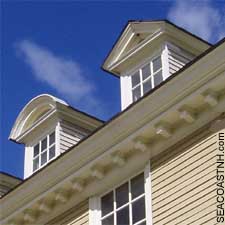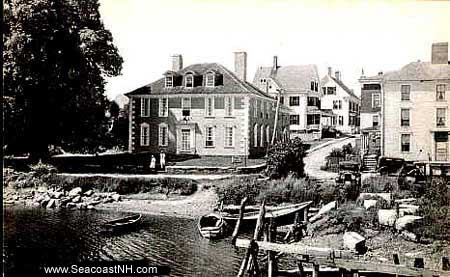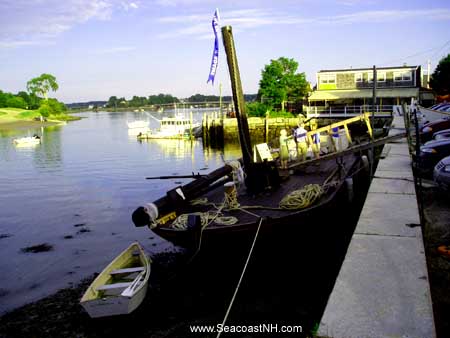|
FRESH STUFF DAILY |
|
|
||
|
|
||
|
|
||
|
SEE ALL SIGNED BOOKS by J. Dennis Robinson click here |
||
It was almost demolished as a slum in 1972. But Portsmouth’s South End survived the onslaught of urban renewal and today is among the most sought after and ritzy places to live in Portsmouth. That’s because it’s history is as old as Portsmouth itself and its new residents live among a host of ghostly neighbors.
Portsmouth's Ancient South End "You don’t buy a house around here," a longtime South-Ender says. "You buy a neighborhood."
Pressed against the fast-flowing Piscataqua River, Portsmouth’s historic South End is among the nation’s longest surviving neighborhoods, dating to the 1650s. Just over from Hunking, at the head of Gardner Street, two neighbors have renovated their ideal home. Susan and Larry Benedict, both educators, have settled in for good. They are part of the South End renaissance of retiring couples drawn to this refurbished maritime setting. Five years ago they bought a 1778 Federal home the first day it came on the market. "We both walked in and we knew this was it," Susan Benedict says. "We are never going to live anywhere else. We’ll die with our boots on here." True to its Federal style, the unadorned exterior draws little attention. The shy 2 1/2-story structure is positioned sideways on a tiny lot, just 34 by 79 feet. Visitors approach from the back that offers only two small central windows and two towering chimneys at each end. There is room for two cars tucked end-to-end and a pocket garden with three raised wooden beds, a tool shed and nothing more. It isn’t everybody’s cup of tea. The original tenants had just four simple rooms and a habitable third floor attic. The current house has a fifth room, the modern kitchen, built on the footprint of an old shed, plus bathrooms up and down. Another small shed has been adapted into a breakfast nook off the kitchen and both look out onto the garden that is wrapped in a high wooden fence. A simple boxy stairway, almost primitive by Portsmouth standards, rises like an elevator up the center of the building. All four original rooms have high ceilings and working fireplaces. Just to the right of the beehive fireplace is a narrow door where a precipitous "secret" staircase leads to the attic. There is a dark spooky basement where nobody goes. CONTINUE WITH STREET ARTICLE
These are the cards the owners were dealt. No rooms can be added, none taken away. The Benedicts brought into this small space their collection of furniture and art. These are the pieces they presented to painter/designer Will Perkins and to carpenter/cabinet maker Bob Lacivita. The owners’ goals were simple -- help us create a beautiful space where we will be happy for the rest of our lives. Before the Benedicts came the Dustons. Seth and Heidi Duston are the avowed "saviors" of the house. They bought the old Federal in the 1990s when it was a wreck. "I really loved that house, but we had no idea what we were getting into," Seth Duston says. "It was our first really heavy-duty restoration. We did most of the work. I like to think we gave it another 100 years. I don’t know how, but I felt like the house was thanking us for doing the work." The Dustons work included shoring up the sagging floor beams. They replaced three-quarters of the rotting sills and had all the wood-frame windows reproduced and installed. They framed in the room that became the modern kitchen, repaired the roof, skim-coated all the walls and replaced the front door with a period fabrication. Seth recalls tearing up the attic floorboards and feeding them out the window to be re-used in the kitchen and taking a sledge hammer to the brickwork to expose that colonial beehive fireplace. He hired a local folksinger, who was also a mason, to completely rebuild a sagging chimney. They did much of the work in 45 days. Then they had their third child, and the house was suddenly too small. Exit the Dustons, who now live in a 1705 colonial in Maine. Enter the Benedicts. Three decades ago, before the South End renaissance, this fading little Federal would not have attracted such loving attention. Portsmouth was just beginning to transform itself from a hard-knuckle seaport with topless bars to a cultural heritage and high-tech center. But the bargain days are over. Touted as one of America’s most livable small cities (population 24,000) Portsmouth, to the chagrin of many locals, is a chic new destination, and real estate rates reflect that trend. The only seaport on New Hampshire’s 17-mile coast, Portsmouth started strong and faded quickly. During its heyday as a British colony, Mark Hunking Wentworth, owned the stunning Georgian mansion (1760) at the foot of Gardner Street, now the Wentworth-Gardner museum. Mark Wentworth was the brother of one royal NH governor, uncle to a second and father to a third. The Benedict home was built when the South End was marked by long wharves fragrant with West Indian spices. Although the details are murky, it is clear that the Laightons, a venerable Portsmouth family, owned most of the land from the top of Gardner Street, which was then called Ann Street, down to the river. Family patriarch Paul Laighton was a block maker. He and his sons crafted the round wooden pulleys used in rigging tall ships. Paul owed his fortune to Mary Mills whom he married in 1756. Her father Luke Mills originally owned the wharf and the towering 1747 colonial that still stands at the river’s edge. That building may have been a tavern. By the 1770s, as the Revolution neared, a series of key family estates were lined along the river like pieces on a Monopoly board – the Laightons, the Wentworths, the Pickerings, and so on. Each rectangular lot had acres of backyard garden or orchard stretching up toward Water Street (now Marcy), one of the defining streets in the sprawling South End. That open land just up from the bustling riverfront became the hot new property as New Hampshire evolved from a provincial colony to an independent state. Because a Tory owned the Wentworth estate next door, Paul Laighton was careful to register himself as a loyal Portsmouth patriot during the Revolution. CONTINUE WITH STREET ARTICLE
Mary Mills Laighton also gave her husband 13 children, four girls and nine boys. The Laighton boom coincided with the best economic years in Portsmouth history. During this era many large family tracts were subdivided and we know that at least three of the Laighton boys built houses in their parent’s back yard. The Benedicts house and an identical Federal next door appeared soon after the start of the Revolution. The 1778 date is an educated guess since no deed has yet been discovered. By 1797, when Paul Laighton’s elderly father-in-law finally deeded him the entire parcel, the houses were there. Paul Laighton immediately passed the land on to his sons. Local historians speculate that Paul may have retired to the smaller Benedict house where the Benedicts will soon retire themselves. His second-youngest son Samuel Laighton, born in 1786, may have lived there next. The paper trail has faded, but we know that Samuel, like all of the Laighton boys, was also a block maker. Samuel would have been only three when President George Washington passed through the South End in 1789. Washington was on his way to Hunking Street to visit the mother of his secretary Tobias Lear. Lear, perhaps the most famous South-ender, also acted as bookkeeper at Mount Vernon and tutor to Washington’s stepchildren. Tobias Lear’s birthplace, a 1740 hip-roofed house, still sits at the end of Hunking Street right next to the Wentworth-Gardner mansion. Both are now South End museums. When you buy a house in the South End, the Benedicts have discovered, you buy into a neighborhood – and its history. Some of those neighbors are alive and some, like the Laightons, the Wentworths and the Lears, are very palpable ghosts who still command attention. One more famous neighbor deserves mention. In 1793, about the same time that Paul Laighton officially got the deed to his side of the street, the Wentworth property next door was sold. The new owner was Major William Gardner, who was also connected to George Washington. During the Revolution, Gardner’s job was to furnish soldiers with supplies, a difficult task since the nascent government had no funds to speak of. Gardner was forced to use his own money, at times, and was never repaid. In thanks Washington made him regional Commissioner of Loans. Gardner set up the United States Loan Office inside an arch that stretched over the street at the top of his property. That would place his unusual office just across Gardner Street from the Benedict house. The Gardner Arch survived until 1850. The appeal of Gardner Street, Susan Benedict says, is that they can live simultaneously in the 18th and the 21st centuries. The trick is to find the perfect balance – the best of both worlds, the worst of neither. "There’s something special about the South End," says Bob Lacivita, a carpenter who has worked on ten South End homes, including the Benedict house. "In New Hampshire people don’t necessarily just walk up and say – Hi, how are you? – but they do here. Maybe because it was a real working-class neighborhood. It was friendly like that when it was all run-down years ago. It’s still like that today." (c) 2007 by J. Dennis Robinson. All rights reserved. A longer version of this article appeared previously in an edition of Early America Life with detailed photographs. Please visit these SeacoastNH.com ad partners.
News about Portsmouth from Fosters.com |
| Friday, April 19, 2024 |


|
Copyright ® 1996-2020 SeacoastNH.com. All rights reserved. Privacy Statement
Site maintained by ad-cetera graphics

 HISTORY
HISTORY



 HISTORIC HOMES
HISTORIC HOMES One stroll through the Portsmouth, New Hampshire waterfront validates his claim. Down Hunking Street toward the Piscataqua River, two-story clapboard homes lean toward each other like ancient trees. A couple holding hands with their arms outstretched can almost touch the buildings on both sides. Colonial, Georgian, Federal and modern homes are jig-sawed together, some touching, others only slightly less familiar.
One stroll through the Portsmouth, New Hampshire waterfront validates his claim. Down Hunking Street toward the Piscataqua River, two-story clapboard homes lean toward each other like ancient trees. A couple holding hands with their arms outstretched can almost touch the buildings on both sides. Colonial, Georgian, Federal and modern homes are jig-sawed together, some touching, others only slightly less familiar. 
















